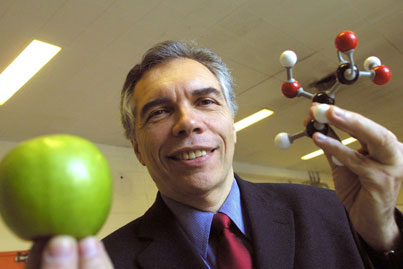Headliners
From bones to bellies and everything in between
Get the lead out—or do you really have to?

Prof. Joe Schwarz tries to tap into the truth.
Owen Egan
Recently, as is his wont, Joe Schwarz was swimming against an onrushing tide of bottled water and water filter enthusiasts as Montreal city officials announced that the tap water of some 75,000 residents might contain slightly more lead than called for by provincial standards. Telling a Montreal Gazette reporter that a scene of absolute “glee in the Brita boardroom” must have broken out following the announcement, the Director of the McGill University Office for Science and Society also said that the higher lead levels are still lower than standards considered safe in the United States. Schwarz has long railed against the water industry, famously calling the spike in popularity of bottled water in recent years “the greatest hoax ever perpetuated on mankind.”
Boning up on grafts

Need a bone graft? Get a printer, say Jake Barralet and his fellow researchers
Owen Egan
While you were throwing out that old ink-jet printer that was collecting dust on your desk, intrepid McGill researchers were using a similar technology to make bone grafts. As reported in Le Devoir and Chemical & Engineering News, Dr. Jake E. Barralet and his colleagues have adapted an ink-jet printer to producing three-dimensional bioceramic “bones” that could one day be used as biodegradable platforms for regenerating missing or damaged bone in patients. In lieu of ink, the printer shoots phosphoric acid in a specific pattern on a layer of calcium phosphate powder. Like a CT scan, the image is created one layer at a time. The Canada Research Chair in Osteoinductive Biomaterials hopes that the new technology will pave the way for breakthroughs in reconstructive surgery or other types of bone repair.
Belaboured breathing blamed on bellies
As if you needed another reason to back away from the Wunderbars and climb aboard a treadmill… A study recently released by Dr. Gerald S. Zavorsky of the MUHC and widely reported by Reuters, among others, has found that morbidly obese men tend to have more breathing difficulties than morbidly obese women, partly because they have much larger waistlines. Because men tend to carry their excess weight a little higher than women, they suffer from a poorer “pulmonary gas exchange.” Dr. Zavorsky suggests that the extra weight around a man’s torso presses on the lungs and impedes breathing.
New HIV patients more likely to spread virus

A word of warning about HIV from Mark Wainberg
Owen Egan
More sobering news on the HIV front: Dr. Mark Wainberg, Director of the McGill AIDS Centre and internationally respected AIDS researcher, is making news with the results of his study demonstrating that half of all new HIV transmissions happen when newly infected people don’t know they are carrying the virus and may not even test positive for it. Covered in everything from Science Daily and the Globe and Mail to the Edmonton Sun and Bloomberg.com, the study is one of the first to quantify how many of the newly infected have spread the disease to partners. “One of the things driving this entire epidemic is that people themselves are newly infected and are often the most infectious they will ever be throughout their lives and not even know it,” said Wainberg.

